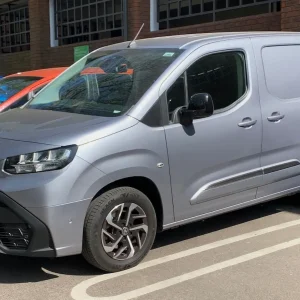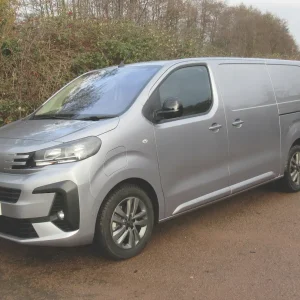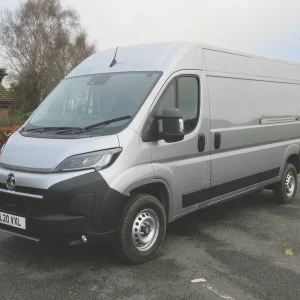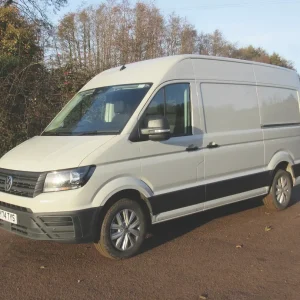While much of today’s focus is on electric light commercials thanks to recent government announcements, the internal combustion engine is far from being dead. The battery-electric Fiat Professional Ducato has attracted plenty of attention, but the diesel versions of the revised front-wheel drive Ducato will comfortably outsell it for some time to come.
Meeting the Euro 6d exhaust emission standard, the upgraded 2.3-litre MultiJet 2 engine is on offer at 120hp, 140hp, 160hp and 180hp compared with the previous 130hp, 150hp and 180hp models. The 115hp 2.0-litre MultiJet II fitted to the old model has been dropped.
Another key change to the 2.3-litre, helping it deliver more torque and more mid-range power, is the introduction of a new turbocharger.
Also fitted is what Fiat Professional refers to as an EcoPack, which is standard. It includes changes to the alternator and fuel pump, which is electronically controlled, plus a start/stop system.
The manufacturer has introduced automatic transmission for the first time. The optional nine-speeder features three different driving modes (Normal, Eco and Power) and two different operating modes (Drive and Autostick). Stick with the first and the box works like a conventional automatic. Switch to the latter, and you can hold onto a lower gear if you are, for example, climbing a steep hill with a heavy load.
The Ducato is also being made available with a variety of different safety packages and driver aids, including Blind Spot Assist and Lane Departure Warning System.
One handy feature is the engine idle preset, designed to increase the engine’s minimum revs to power any additional electrical equipment that may have been installed. Another is the installation of more-powerful LED cargo area lights, which are available in three different sizes according to the vehicle’s wheelbase.
Worthy of note is the availability of a new infotainment package with a 7in touch-screen, USB port and DAB radio with remote controls located on the steering wheel.
Apple CarPlay is integrated into the package and it is also compatible with Android Auto. The built-in navigation system allows the Ducato’s dimensions to be inputted, meaning that streets that are unsuitable for a vehicle of its size can be avoided. This is a remarkably bright idea, which should help prevent drivers from getting embarrassingly stuck in tight spots.
Sharing the same basic design features as Peugeot’s Boxer and Citroen’s Relay – though not their engines – the Ducato is produced with three different wheelbases and three different heights. Load cubes range from 8.0m3 to 17.0m3, gross weights extend from 3.0t to 4.25t, while payload capacities range from 1,060kg to 2,140kg.
It is also produced as a crew van with a rear cargo compartment, a window van, a chassis cab, a chassis crew cab and a platform cab. The Ducato is additionally available as a dropside, an end tipper and a three-way tipper. There are three trim levels on offer – Standard, Tecnico and Sportivo – plus the Shadow special edition.
We got to grips with a 3.5t, long-wheelbase high-roof Ducato 35 with 140hp on tap and Tecnico trim. So, how did it fare?
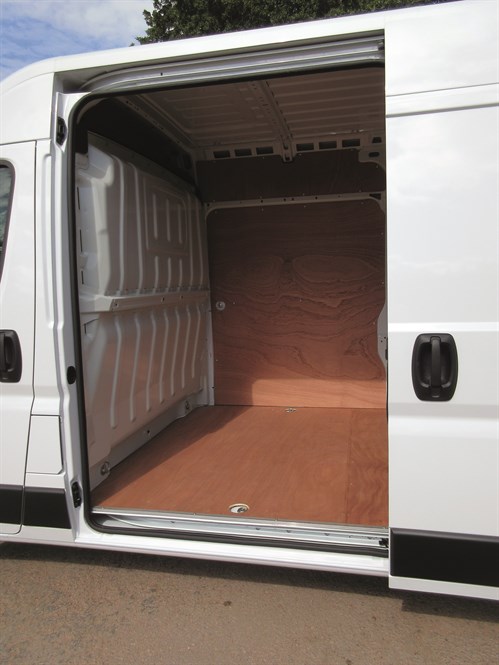
Load bay
Rear access to the 13.0m3 load area is by means of twin rear doors. which can be swung through 90 degrees, or through 180 degrees by pushing the buttons that release the stays. An alternative means of entry is provided by a sliding nearside door.
Both entrances lead to an impressively low-cargo bed with an ample selection of tie-down points. More are to be found along the sides of the load bay.
A shelf above the cab provides extra storage space. Complete with a substantial-looking steel bulkhead, the load area had been timber lined and we were impressed by the quality of the materials used.
All the doors (including the cab doors) have large exterior handles that are easy to grasp. This makes life easier if you are wearing thick working gloves and the weather is too chilly for you to take them off.
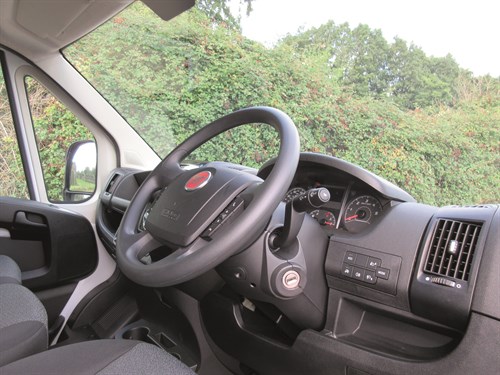
Interior and equipment
The provision of storage facilities in the three-seater cab is little short of excellent – perfect for all the accoutrements drivers often end up carting around with them.
While the glovebox is small and not lockable there are two roomy shelves above it, plus a lidded compartment on top of the dashboard. Sitting next to it are four trays of various sizes. Each of the doors boasts a pair of bins, with the bigger of the two featuring a moulding that can easily clasp a big bottle of water.
Fold the centre section of the middle seat’s back forwards and it turns into a desk with two cup holders, a pen tray and a clip to keep paperwork tidy. Another cup holder sits on the fascia with a 12v power socket next to it.
At the bottom of the dashboard there is a module with a USB socket and two additional trays, plus a couple more cup holders. Although this is a useful feature, it slightly restricts the middle passenger’s legroom.
Our demonstrator’s infotainment package featured a rather-too-small 5in touchscreen, a DAB radio, Bluetooth connectivity and satellite navigation. Electric windows, heated and electrically-adjustable exterior mirrors, an alarm, cruise control with a variable speed limiter, and a driver’s airbag are also included in the Tecnico deal, as are reversing sensors and manual air conditioning.
The heating and ventilation controls are big and chunky. That is something we would normally welcome, but they also felt stiff and clumsy.
Onboard safety devices include ABS, Electronic Brakeforce Distribution, Electronic Stability Control and an Anti-Slip Regulation (ASR) traction control system, which can be switched off.
We would like to see a more comprehensive safety package, with some of the items referred to in the introduction made standard. Power-assisted rack and pinion steering is fitted and delivers a 14.3m kerb-to-kerb turning circle.
The Ducato’s front suspension is independent, with MacPherson struts and an anti-roll bar, while a rigid tubular axle with parabolic longitudinal leaf springs helps support the rear. Telescopic shock absorbers are deployed all around.
Disc brakes are installed all round as well, and our demonstrator’s 15in wheels were shod with Bridgestone Duravis 215/70 R15C tyres. It’s good to see that a full-size spare is provided.
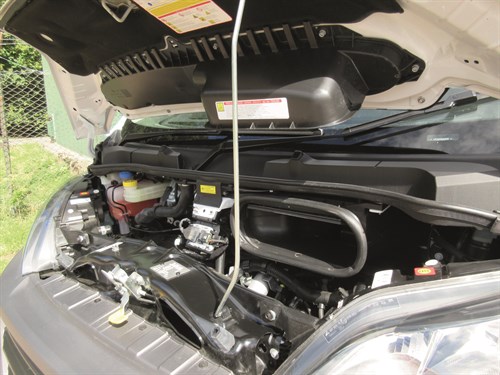
Powertrain
Equipped with common rail direct fuel injection, a variable geometry turbocharger and an intercooler, and married to a standard six-speed manual gearbox, our Ducato’s four-cylinder engine developed maximum power at 3,600rpm.
Top torque of 350Nm kicked in at 1,400rpm. The 2.3-litre makes use of AdBlue housed in a 19-litre reservoir to meet Euro 6d standards.
Driving
Ducato’s handling is undoubtedly rewarding. Push the van into a bend and it responds positively, with lots of meaty feedback through the steering keeping you in constant contact with the road.
Low-speed manoeuvrability is impressive too, making it easy to swing into and out of tight parking spaces.
There is no denying that the engine packs more than enough punch, propelling you swiftly away from rest and with plenty of mid-range acceleration on tap. It makes the Ducato a more than sensible choice for high-speed intercity runs.
On the negative side, the gear change was less than precise and the ride was adequate rather than outstanding. In-cab noise levels were a touch too high, and the driving position could definitely do with some improvement.
With the steering wheel offset to the left – presumably a consequence of the need to produce right-hand drive models – the driver ends up being twisted ever so slightly to one side; and that is unacceptable.
At least the wheel and seat are height-adjustable, and the latter boasts lumbar adjustment and an armrest.
Vision ahead and to either side from behind the wheel is good, and deep windscreen and deep cab door windows make it easier to spot vulnerable road users. The large exterior rear view mirrors with their lower wide-angle section make life easier and safer too.
Drivers should still take care when they are leaving the cab, though.The handbrake lever sits between the driver’s seat and door, and can prod you if you are not careful.
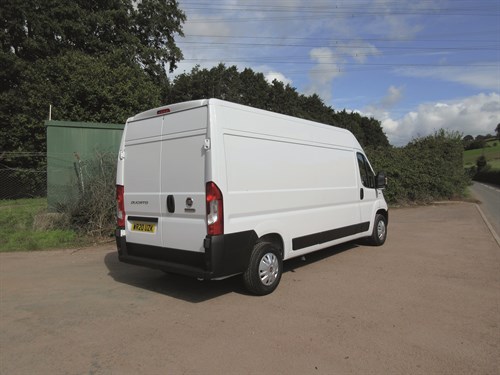
Operating
The Ducato comes with a three-year/100,000mls warranty with roadside assistance included for the first year.
Service intervals are set at two years/36,000mls; prudent operators will of course ensure their hard-working vans visit a workshop more frequently for interim checks.
We averaged around 35mpg compared with the official Worldwide Harmonised Light Vehicle Test Procedure (WLTP) figure of 31.4mpg. An Eco button stands ready to hand
to help keep consumption down, and its use does not affect performance too much.
While Fiat Professional’s build quality does not meet the high standards set by rivals such as Volkswagen and Mercedes-Benz, the Ducato is nevertheless well put together, with no tell-tale squeaks or groans. What’s more, side rubbing strips help protect the bodywork from any minor damage.
Fiat Professional Ducato Van 35 140hp LWB HR Tecnico
Price (ex VAT) £32,605
Price range (ex VAT) £25,655-£40,950
Gross payload 1490kg
Load length 3705mm
Load width (min/max) 1422mm/1870mm
Load bay height 1932mm
Load volume 13.0m3
Loading height 535mm
Rear door aperture 1562mm x 1790mm
Side door aperture 1250mm x 1755mm
Gross vehicle weight 3500kg
Braked trailer towing weight 2250kg
Residual value 15.2%
Cost per mile 61.3p
Engine size/power 2287cc, 140hp @ 3600rpm
Torque 350Nm @ 1400rpm
Gearbox 6sp
Fuel economy (combined, WLTP) 31.4mpg
Fuel tank 75 litres
CO2 236g/km
Warranty 3yrs/100,000mls
Service intervals 2yrs/36,000mls
Insurance group 41A
Price as tested £32,605
* after 48 months @ 20,000mls/year – source – KWIKcarcost
Rivals
Ford Transit
Price (ex VAT)£26,725-£42,795
Load volume 9.5-15.1m3
Gross payload 895-2209kg
Engines 105hp, 130hp, 160hp, 170hp, 185hp 2.0 diesel, 130hp 2.0 hybrid diesel
Verdict: We’ll have to wait until spring 2022 – far too long – for the all-electric E-Transit, but at least it is on its way. In the meantime, the rear-wheel drive version of Ford’s big seller is at last available with a 10-speed automatic gearbox with an eye to the needs of the home delivery fleets. Transit remains an industry benchmark, with healthy residual values and the support of a comprehensive dealer network.
Mercedes-Benz Sprinter
Price (ex VAT) £26,550-£52,475
Load volume 7.8-17m3
Gross payload 842-2529kg
Engines 150hp, 170hp 2.0 diesel, 143hp, 163hp 2.1 diesel, 190hp 3.0 diesel, 85kW electric
Verdict: The mainstay of supermarket home delivery operations, and now available in battery-electric eSprinter guise, the durable Sprinter should appeal to businesses that rank safety and connectivity among their priorities. Customers can choose from front, rear or four-wheel-drive configurations, with seven and nine-speed automatic transmissions among the list of options.
Renault Master
Price (ex VAT) £27,800-£61,800
Load volume 8.0-17m3
Gross payload 848-1990kg
Engines 130hp, 135hp, 145hp, 150hp, 180hp 2.3 diesel,
57kW electric
Verdict: 2019 saw the Master receive a makeover, with external restyling, a revamped cab interior, extra safety devices and changes to its 2.3-litre diesel. It rides and handles well, is frugal, and payload capacity is respectable, but build quality needs to be improved. It is marketed by Renault Trucks as well as Renault’s car and van operation, by Vauxhall as the Movano, and by Nissan as the NV400.
The Final Verdict
Design 7/10 – Payload capacity and ease of loading are definite plus-points.
Cabin 6/10 – Plenty of storage space, but the offset steering wheel is a real problem.
Ride 7/10 – Acceptable, but not outstanding. It improves with more weight in the back.
Refinement 7/10 – Well put together, but in-cab noise levels need some attention.
Load area 9/10 – Easy to manoeuvre heavy items onboard and payload capacity is impressive.
Handling/performance 8/10 – Former is exemplary, the latter is well up to standard.
Engine/transmission 7/10 – Former is impressive, the latter less so – gear change could be a lot smoother.
Standard equipment 7/10 – Most creature comforts are provided, but more safety systems would be good.
Operating costs 8/10 – A sensible warranty package, plus long service intervals.
What Van? subjective rating 7/10 – Definitely heading in the right direction, but there is still room for improvement.
Overall Rating: 73/100

